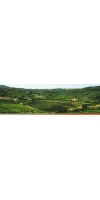Wine from Pinino Societa Agricola

Pinino Societa Agricola Estate
Pinino is a wine producer, located in Tuscany, in the village of Montalcino. They produce Brunello di Montalcino, made with 100% Sangiovese grape variety. It is a modern winery, with an accent to clean, traditional winemaking.
Date Founded: 2003
Pinino wine estate was founded in 1874 by Tito Costanti, Notary public of Montalcino. In 2003, the property was purchased by Andrea and Hannes Gamon of Austria and Max and Silvia Hernandez of Spain with the vision to produce 1st class wines, derived from a common passion.
"Pinino" is the historical name of the winery that was founded in 1874 and was one of the first companies to be inscribed to Consorzio del Vino Brunello
This Estate's vineyards are spread over 16.5 hectares (41 acres). 100% Sangiovese.
No products found
- back
Selected Options
Wineries
Categories
Pricing
Countries
Regions
Grape Types
Wineries
Organic/Free Shipping
All older vintage wines have been purchased from a single collectors cellar. Pictures can be requested before shipment.
Montes Alpha M 2019 is made from 80% Cabernet Sauvignon, 10% Cabernet Franc, 5% Merlot, 5% Petit Verdot.
Montes Alpha M is the result of an extremely limited production and a rigorous selection of the grapes, one by one, led by Aurelio Montes. Coming from the Colchagua Valley, it is one of the best and most awarded wines of Chile. The vineyards that give rise to Montes Alpha M are located in the Apalta zone of the Colchagua Valley. The soils are of granitic origin and are shallow in the upper, mountainous sectors. They vary in the clay content, depth, amount of organic matter, and especially the types of rocks and stones they are made up of. The soils origin can also range from fluvial to glacial, which shows the great diversity of soils in our vineyards. Some zones are influenced by the Tinguiririca River and others by mudslides and the detachment of material from high above in the mountain chain that delimits the valley.
- Extremely limited production where grapes are hand selected one by one.
- Only released if head winemaker, Aurelio Montes approves the quality.
- Originating from Colchagua Valley, one of the best and most awarded Chilean wines.
- Aged in new French oak barrels for 18 months.
- Smooth but structured on the palate, with silky tannins.
Review:
Deep nose, but really fresh at the same time. Currants, blackberries and chili-pepper chocolate with cedary and meaty undertones. This is really juicy, with a tight, tensely framed palate, underscored by lots of creamy, dusty tannins. A lengthy, refined and elegant expression of cabernet sauvignon, but a strong statement from Colchagua. Drink or hold.
-James Suckling 97 Points




